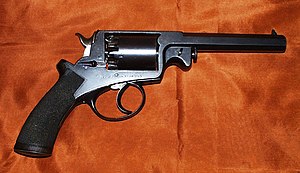Adams Patent Small Arms Company
Револьвер Adams M 1868 Mk I / M 1872 Mk II / M 1872 Mk III
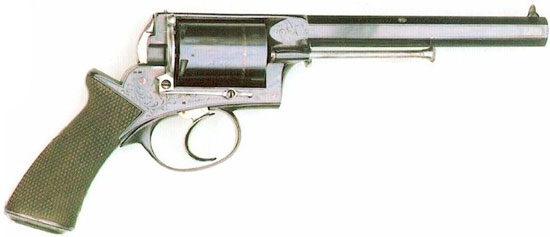
В 1851 году талантливый английский оружейник Роберт Адамс (Robert Adams) запатентовал новую конструкцию самовзводного капсюльного револьвера собственной разработки. В 1855 году этот револьвер усовершенствовали, главным изменением которого стало использование нового ударно-спускового механизма Фредерика Бьюмонта, и приняли на вооружение Британской армии под названием «Beaumont-Adams Revolver».
Однако к тому времени дни капсульного оружия уже были сочтены, и в 1868 году брат Роберта Адамса – Джон Адамс (John Adams) предложил свой револьвер под унитарный патрон с дымным порохом. Эта модель стала известна с обозначением Adams Mk I.
Револьвер Адамса образца 1868 года представлял собой переделочный вариант модели Adams M 1851.
Джон Адамс снабдил свой револьвер барабаном новой конструкции, шомполом-выбрасывателем и дверцей для заряжания, превратив таким образом капсюльный револьвер в казнозарядный. Цельная рамка, выполненная зацело с восьмигранным стволом, самовзводный УСМ и рукоятка были аналогичны таковым в модели 1851 года.
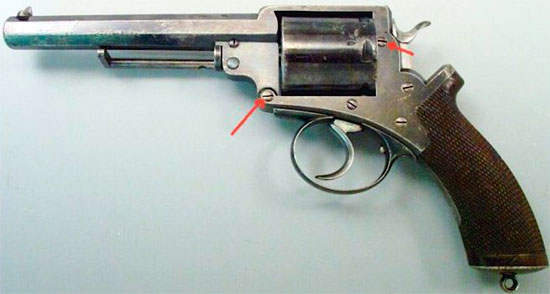
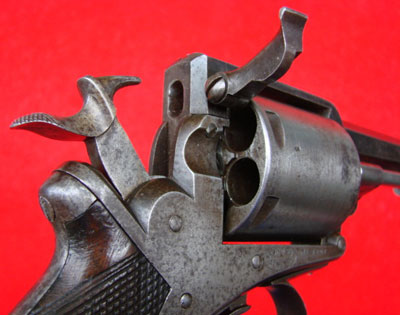
Револьвер Адамса образца 1868 года имел барабан на пять камор и зарядную дверцу справа, которая открывалась назад. Нижняя часть зарядной дверцы фиксировалась плоской пружиной, привинченной к нижней части рамки, которая удерживала дверцу либо в закрытом, либо в открытом положении. Фиксатор на левой стороне рамки, предотвращавший выпадение патронов, был вставлен перед предохранительной пружиной, которая не позволяла курку соприкасаться с патроном. Для экстракции гильз из барабана под стволом с правой стороны был расположен простой шомпол-экстрактор.
В начале 1872 года Джон Адамс предложил модифицированный вариант револьвера образца 1868 года, в конструкцию которого были внесены существенные изменения. В этом револьвере были использованы новые рамка, зарядная дверца, ударно-спусковой механизм, шестизарядный барабан и усовершенствованный экстрактор. Новая модель получила обозначение Adams Mk II.
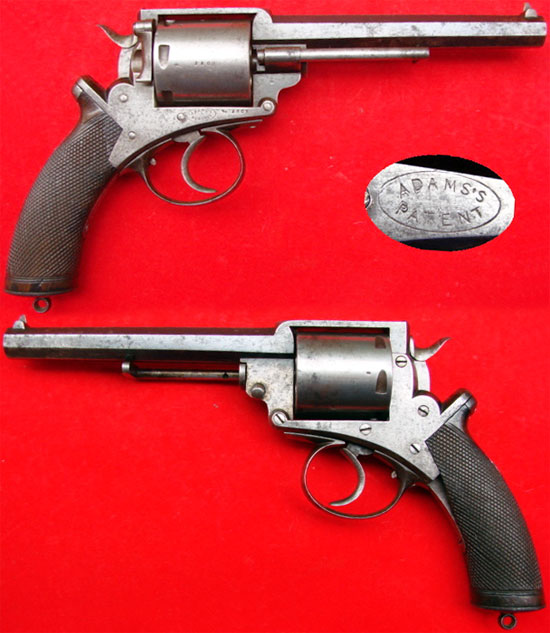
С технической точки зрения револьвер Adams M 1872 Mk II представляет собой револьвер с рамкой, состоящей из двух частей.
Ствол восьмигранный, нарезной, представляет единое целое с верхней частью рамки револьвера.
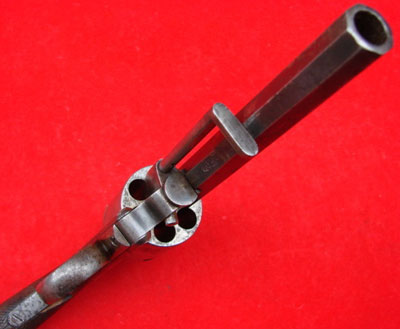
Ствол в передней части имеет прилив, переходящий в рамку. В приливе высверлено отверстие, сквозь которое проходит плотно зафиксированный стержень с плоской насадкой на переднем крае, служащий осью барабана. С правой стороны прилива расположен кронштейн, удерживающий подпружиненный экстрактор.
Барабан гладкий, с шестью каморами. Перезаряжание барабана осуществляется через окошко на правой стороне оружия, которое в обычном положении закрывается дверцей. Удаление стреляных гильз производится последовательно с помощью неубирающегося экстрактора, расположенного правее и ниже ствола, при открытой дверце барабана с правой стороны. Зарядная дверца открывается в сторону вверх.
Ударно-спусковой механизм куркового типа двойного действия.
Прицельные приспособления – фиксированные, простейшего типа, состоят из мушки и целика, прорезанного в задней верхней части рамки.
Спусковая скоба округлая, спусковой крючок С-образный.
Рукоять имеет стальную рамку, состоит из цельного куска дерева, резанного мелкой сеткой. Снизу рукоятки овальный затыльник с кольцом для страховочного ремешка.
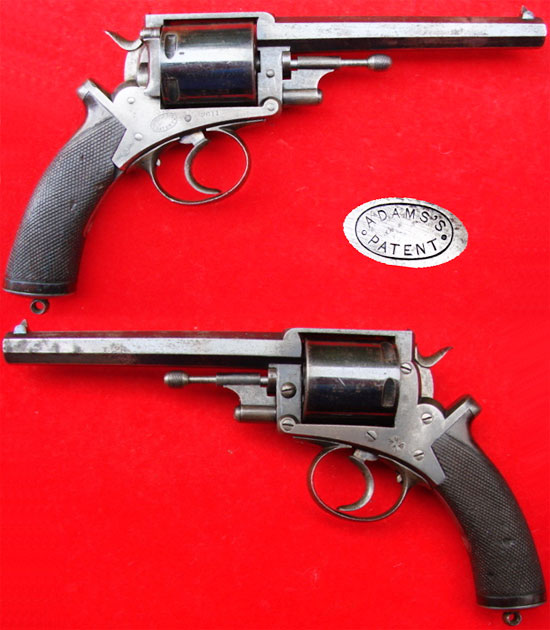
Во второй половине 1872 года Джон Адамс в очередной раз модифицировал свой револьвер, заменив расположенный правее и ниже ствола экстрактор на экстрактор, вынимающийся из оси барабана и поворачивающийся вместе с шомпольной трубкой на оси. Этот револьвер получил обозначение Adams Mk III и был принят на вооружение Великобритании.
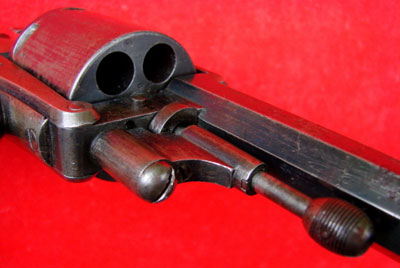
Револьвер Adams M 1872 Mk III состоял на вооружении британской армии и флота, а также Канадской Королевской Конной Полиции, использовался в Англо-Зулусской и в ходе многочисленных колониальных войн. Был широко распространен в английских колониях и пользовался популярностью в других странах. Также он пользовался спросом и у гражданских лиц, но, в связи с большим количеством военных заказов, коммерческого оружия было выпущено весьма незначительное количество.
Производство револьверов Adams Mk III образца 1872 было налажено компанией «Adams Patent Small Arms Company», основанной Джоном Адамсом и снабжавшей британские вооруженные силы вплоть до принятия на вооружение Великобритании револьвера Enfield Mark I в 1880 году.
Robert Adams Designed a Revolver to Outshoot the Famous Colt
Adams and Colt battled over the 19th-century pistol market
by MATTHEW MOSS
By 1850, Samuel Colt had come to dominate the American revolver market, aggressively defending his patents and using advanced manufacturing processes to out-produce rivals.
Meanwhile in February 1851, British gunsmith Robert Adams patented his double-action revolver design.
The key advantages Adams’ revolvers had over Colt’s were their larger caliber and double action. This made them fast-firing and hard hitting. You could shoot them with one hand, making them ideal for the sort of close-quarters combat British officers found themselves in during colonial campaigns.

Colt attempted to gain a foothold in Europe in the early 1850s, setting up a lavish display featuring his pistols at the Great Exhibition. It was at the exhibition that Colt faced his first competition from Adams.
London gunmakers George and John Deane’s stand displayed a plethora of products from a number of British gunmakers from London and Birmingham. Among them was a finely-decorated Adams Revolver, which enjoyed much interest from visitors.
Despite Colt gifting various presentation pistols to dignitaries and demonstrating the impressive interchangeability of his weapon to fascinated crowds, at the end of the exhibition Deane & Deane won a prize medal while Colt received only an honorable mention.

Undeterred, in 1852 Colt established a factory in London, hoping to gain lucrative military contracts from Britain and Europe. Initial orders from the Royal Navy for 9,500 revolvers and the British Army for 14,000 revolvers were encouraging. But the British became steadily more interested in Adams’ revolvers.
During trials at the Woolwich Arsenal, testers found that the Adams was faster to reload — 38 seconds to the Colt’s 58 second. The Adams was also more accurate and suffered no misfires, unlike the Colt.
Colt was unwilling to move away from his own open-frame, single-action designs in order to compete with his British rival. In 1856, Colt was compelled to close his factory.
Adams himself had initially worked as manager of the Deanes’ factory. It was with Deane & Deane that he first manufactured and sold his revolver. The success of the pistol following its unveiling at the Great Exhibition in 1851 saw Adams elevated to partner with Deane & Deane.
Adams’ design was the first successful double-action pistol on the market. With the pull of the trigger, the gun’s cylinder indexed and the hammer cocked and dropped — firing the gun.
Not only was Adams’ revolver the first double-action revolver, it also had a rudimentary safety mechanism. Adams added a flat spring to the left side of the frame that the shooter could depress into the frame, locking a pall into the hammer and preventing it from going forward.
Adams’ first pistol, the ‘Dragoon’ model of 1851, fired a large .49-caliber ball with immense stopping power. This model had a long barrel, making it cumbersome in close quarters.
Adams also introduced an infantry revolver chambered in .44 caliber. This second, improved model had a shorter barrel. Adams’ revolver still lacked a loading lever and throughout the weapons life, the gunmaker added a number of different loading systems, including those patented by John Rigby and James Kerr.
 Brevet-Major Sir Charles Russell shoots a Russian soldier with his pistol at the 1854 Battle of Inkerman in this painting by Louis William Desanges
Brevet-Major Sir Charles Russell shoots a Russian soldier with his pistol at the 1854 Battle of Inkerman in this painting by Louis William Desanges
While some elements of the British military were skeptical of the advantages of the revolver, experience during the Crimean War and Indian Mutiny of 1857 began to change opinion. Captain Joshua Crosse of the 88th Regiment of Foot — the Connaught Rangers — wrote to Adams after the 1854 Battle of Inkerman, describing how his Adams Revolver saved his life.
“I then found the advantages of your pistol over that of Colonel Colt’s, for had I to cock before each shot I should have lost my life; but with yours, having only to pull the trigger, I was able to shoot four Russians, and therefore save my life,” Crosse wrote. “I should not have had time to cock, for they were too close to me, being only a few yards from me, so close that I was bayoneted through the thigh immediately after shooting the fourth man.”
Crosse was not alone. During the Indian Mutiny, many officers regretted their lack of a revolver. A Lieutenant Kutznow mourned that he “had not had a couple of revolvers.” Instead, officers and cavalry relied upon the standard issue muzzle-loading percussion pistols.
 Sepoy mutineers attacking the British magazine in Delhi in May 1857. Art via ‘Encyclopædia Britannica’
Sepoy mutineers attacking the British magazine in Delhi in May 1857. Art via ‘Encyclopædia Britannica’
Colt embraced more modern mass-production methods. Adams’ guns, by contrast, were produced by a dozen small makers in Britain and Belgium. This slowed overall production, but the fit and finish of the Adams-pattern revolvers were better.
Adams’ revolvers were also marginally quicker to reload, the lack of integral loading lever notwithstanding. They also benefited from a solid frame with a top strap — something Colt would not introduced until 1873.
One complaint was that, while the double-action trigger made the revolvers fast-firing, the heavy trigger-pull affected accuracy. Adams rectified this problem in 1855 first by adding a hesitation lock and later by integrating a single- and double-action lock patented by Lt. Frederick Beaumont, an officer from the Royal Engineers who admired Adams’ pistol.
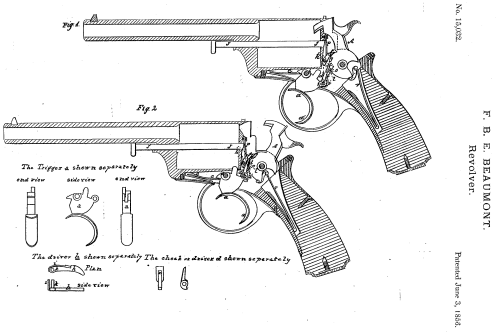 Frederick Beaumont’s improved double action lock patent
Frederick Beaumont’s improved double action lock patent
Beaumont added a thumb spur to the hammer and an extra sear to hold the hammer when it was manually cocked. An animation of this process can be found here.
The Beaumont-Adams Revolver also added a safety of sorts with the addition of a sliding stop that prevented the indexing of a new cylinder.
Despite an initially successful partnership with Deane & Deane, Adams left to form his own company in February 1856. The newly incorporated London Armoury Company produced the improved Beaumont-Adams Revolvers, which also featured a new integral loading lever designed by Kerr, Adams’ cousin and a stockholder in the new company.
Kerr later invented the Kerr’s Patent Revolver, which was also produced by the London Armoury Company after Adams left the firm in 1859.
By the mid-1850s, the British government had made significant purchases of Adams’ revolvers — buying 19,400 Beaumont-Adams in 1855 and 1856 and a further 7,300 breech-loading Mk I, II & III Adams Revolvers between 1869 and 1880. Despite these orders, it was not until 1878 that the British Army issued revolvers to mounted troops.
Improvements continued, and in 1860 Robert’s brother John Adams patented his improved, two-part revolver frame, which simplified the manufacturing process. With the invention and increasing popularity of metallic cartridges in the late 1860s, John also patented a method of converting cap-and-ball revolvers to fire the new cartridges. These refitted pistols and later Adams designs fired self-contained cartridges and were adopted by the British Army in the late 1860s and throughout the 1870s.
In 1867 John Adams formed his own company, the Adams Patent Small Arms Company. Building on his brother’s earlier work, he patented his own revolver design which the British government adopted as a replacement for the older Beaumont-Adams Revolvers.
John’s new pistol was chambered in .45 caliber and had a six-chamber cylinder. It was the British Army’s first self-contained, center-fire revolver. The army adopted the new Mk. I Adams in 1868, the Mk. II in 1872 and the Mk. III in 1878. The Mk. III was the culmination of a number of improvements over previous models and boasted a more efficient extractor and a better loading gate.
The various Adams Revolvers saw action across the British Empire during the Indian Mutiny, the Bhutan War, the Anglo-Zulu War and Second Anglo-Afghan War. They were the British Army’s standard-issue sidearms until the early 1880s, when the Enfield Mk. I debuted.
Robert Adams died in 1880 at the age of 71.

- Hiram Percy Maxim Was a Firearms-Suppressing Genius
- Mitchell WerBell Silenced the U.S. Army’s M-14s and M-16s
- The Lewis Gun Was a New Kind of Killing Machine
Adams Arms Company Overview
Table of Contents
Wonders never cease, folks. It’s true. Just take a look a the AR15 platform. It has been over 70 years since Eugene Stoner came up with the original designs for that rifle, and it is still being studied, followed, and improved upon. It seems that every firearms company in the known universe has some variant of this highly successful and world-famous invention, and it is no wonder why.
Some say that the AR15 platforms is in its final throes, and that any day now it will be relieved of duty, and replaced by more advanced weapons systems. Could be, but for now, the rifle is still as popular as ever. As the famous long-time Youtuber ‘hickok45’ put it: “no home is complete without an AR15”. By and large, it’s one of the go-to systems for entry-level shooters and home-defenders all over the country.
Adams Arms
Founded in 2007 by Jim Granger, the company set out to improve on the modern-day AR15 systems. A first patent was granted to the company in December of 2008, and two more followed in its footsteps. In 2011, a lawsuit against SIG Sauer was filed, but Adams’ claims of patent infringement were denied.
Adams’ headquarters can be found in Palm Harbor, Florida. After the company tinkered with uppers and other components, they went ahead and began producing rifles in 2012 – complete with custom Adams Arms components – in a variety of calibers and setups. Nowadays, the company manufactures piston-driven rifles and uppers, related parts and accessories for the AR15 system, as well as elements for handguns.
VooDoo Innovations – Adams’ sister company – was launched in 2013. It delivers various coatings and processes to the direct impingement system. Adams didn’t want to limit their share of the market to those who use piston-driven rifles, so as of 2016 VooDoo also manufactures quality slides for the Glock 17 and 19.
Adams Arms Piston Kit
The AR15 was originally designed with a direct impingement gas system of operation in mind. With that system, gas is redirected into the rifle in order to move the action and get the weapon to cycle. The DI system is reliable and accurate, but it is not without its shortcomings.
For those who are interested in switching their AR’s system, Adams Arms introduced the piston kit. Many other manufacturers are offering similar kits. Piston-driven guns are noticeably cleaner, they give off less heat, they release gases away from the operator, and because of this they are usually more expensive to obtain or build – though not always.
With the Adams patented piston kit, you end up with a cooler, cleaner, and more advanced system, without having to go through complex mods and reconfigurations. Adams’ kit also allows the gas block to be adjusted, making it ideal for suppressed fire, heavier ammunition, and similar applications.
MSRP starting at $199.99
Adams Arms Upper
Adams has several upper receivers in its catalog, corresponding with its patented P-series black rifles. These receivers will fit any AR15 lower receiver, as long as it is mil-spec. In other words, any standard AR15.
P1 is geared more towards beginning AR shooters, while P2 has Adams’ M-LOK rail system, ambi-charging handle, and a flash hider by VooDoo Innovations. P3 encompasses the company’s competition models, complete with match-grade elements and abilities.
- P1 5.56mm
- Entry level upper
- 16” chrome moly vanadium steel barrel
- Weight 4.4 lbs
- MSRP $599.99
- P2 5.56mm
- Tactical upper
- 11.5” chrome moly vanadium steel barrel
- Weight 3.6 lbs
- MSRP $999.99
- P2 5.56mm
- Tactical upper
- 7.5” chrome moly vanadium steel barrel
- Weight 3.5 lbs
- MSRP $999.99
Adams Arms 308
5.56mm is a fine cartridge, but there is no denying that the .308 packs a heavier punch. By its very definition, it is the heavier and fatter round. Adams Arms has a variety of firearms chambered in 308, as part of their P-series of rifles.
What is so enticing about Adams’ 308 rifles and uppers is their “small frame” format, which retains over 50 percent of your everyday AR15 elements. This makes the switch from 5.56mm to .308 that much easier and more streamlined.
- P1 Rifle
- Entry level rifle
- 16” chrome moly vanadium steel barrel
- Length 34”
- Weight 7.9 lbs
- MSRP $1,299
- P2 Rifle
- Tactical rifle
- 16” chrome moly vanadium steel barrel
- Length 34”
- Weight 8.1 lbs
- MSRP $1,549
- P2 SBR
- Short-barreled rifle
- 12.5” chrome moly vanadium steel barrel
- Length 34”
- Weight 8.1 lbs
- MSRP $1,599
- P2 Pistol
- Short-barreled pistol model with brace
- 12.5” chrome moly vanadium steel barrel
- Length 34”
- Weight 6.9 lbs
- MSRP $1,599
- P3 Rifle
- High-performance model
- 18” chrome moly vanadium steel barrel
- Length 39”
- Weight 8.5 lbs
- MSRP $2,499
- P3 Rifle
- High-performance model
- 16” chrome moly vanadium steel barrel
- Length 34”
- Weight 8.1 lbs
- MSRP $2,499
These models – as well as the previous ones mentioned – include a limited lifetime warranty from Adams Arms. The company will cover any issues and manufacturer defects in their piston-driven systems and parts, for life. Furthermore, their customer service seems to be helpful, though less attainable during the busy season. Perhaps that has changed by now.
I don’t have any personal experience with their customer service reps, but after doing a bit of digging online I found that they are considered to be spot-on with their service. Most of the experiences I read up on were positive ones, with one or two saying that they will never buy from them again.
I tend to go with the majority, since no company has 100% positive feedback from its buyers. Companies are people – people make mistakes. Therefore, you will always find someone with something to say about this or that, whether it’s the product itself or the service.
Conclusion
Like I said, wonders never cease. Nowadays, weapons are becoming more advanced by the day – or so it seems. True, many times it takes a while (sometimes too long a while) for the advanced models to trickle down to the civilian public, but eventually they get there in one form or another.
The fact that we are still using Stoner’s and Browning’s designs and inventions (just for instance) is a real testament to their greatness and ingenuity. The rifles and components which Adams Arms manufactures builds on the brilliance of those individuals who came before it. Like many other firearms production outfits, Adams is standing on the shoulders of giants and looking out into the future.
Adams’ proprietary piston-driven system is not for everyone. Many AR enthusiasts wouldn’t be bothered to make the switch from DI to piston, nor purchase a piston-driven system to begin with. For many AR shooters, DI is quite enough. If, however, you find yourself in need of a piston AR, or are interested in switching over from your DI system, give Adams some of your time, do your research, and see if it fits your needs.
Their prices are reasonable, their products are well-respected, and they deliver on their promise overall.
Sam M
Sam is an avid firearms enthusiast who loves sharing his knowledge and experience with fellow gunivores.
Let us know what you think in the comments section!
Beaumont–Adams revolver
The Beaumont–Adams revolver is a black powder, double-action, percussion revolver. Originally adopted by the British Army in .442 calibre (54-bore, 11.2mm) in 1856, it was replaced in British service in 1880 by the .476 calibre (11.6mm) [1] Enfield Mk I revolver.
History [ edit ]
On 20 February 1856, Lieutenant Frederick E. B. Beaumont of the Royal Engineers was granted a British patent for improvements to the Adams revolver which allowed them to be cocked and fired either by manually cocking the hammer as in single-action revolvers, or by just pulling the trigger. Beaumont was granted a US Patent (no. 15,032 [2] ) on 3 June of the same year.



British Army Mark III, Model of 1872
At that time there was intense competition between Adams and Colt, which was rapidly expanding its sales and had opened a London factory competing with the British firearms trade, manufacturing firearms with interchangeable parts. The older 1851 and 1854 Adams revolvers were self-cocking, also known as double-action. The Adams revolver was favoured by British officers in the Crimean War and colonial conflicts due to the stopping power of its larger 54 bore (.442 cal) bullet (compared with their main competitor, the smaller .36 cal Colt Navy revolvers), and the speed of the Adams trigger-cocking action for close-quarters fighting (over the more cumbersome Colt action). [3]
In partnership with George and John Deane, the company of Deane, Adams & Deane produced the new revolver in a variety of calibres and sizes, from pocket pistols to large military versions. The United Kingdom officially adopted the 54-bore (.442 calibre) Beaumont–Adams in 1856, [4] Holland and Russia following soon after. To meet the growing demand for its weapons, Deane, Adams & Deane contracted companies in Birmingham and Liége to manufacture their weapons under licence. [3] The new revolver gave Robert Adams a strong competitive advantage and Samuel Colt shut his London factory due to a drop in sales.
In the US, the Massachusetts Arms Company was licensed to manufacture about 19,000 specimens of the gun in .36 calibre, of which about 1,750 were purchased by the Union Army at the beginning of the American Civil War. They also made a pocket version in .32 calibre.
In 1867, Robert Adams’ brother John Adams patented a breech-loading revolver which was adopted by the British government in place of the Beaumont–Adams. It was a solid frame pistol with six chambers, in .450 caliber. After official acceptance of his pistol, Adams left the London Armoury Company and established his own factory, the Adams Patent Small Arms Company. His pistol was manufactured in three distinct variations (differences related mainly to methods of spent cartridge ejection) between 1867 and about 1880. The models were tested and adopted by the British Army and Navy, with the last, the M1872 Mark III, seeing the widest use.
The John Adams revolver remained the official sidearm of the British Army until replaced by the Enfield Mark I in 1880.


